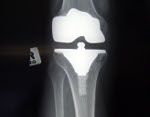What is Psoriatic Arthritis?
Published by Steve Hedberg on June 25, 2009 Under arthritis
 Psoriatic Arthritis is grouped with a number of other types of arthritis called spondyloarthropathies. Psoriatic arthritis differs from some of the other kinds of arthritis in that its symptoms not only include the common arthritis symptoms, but also psoriasis of the skin.
Psoriatic Arthritis is grouped with a number of other types of arthritis called spondyloarthropathies. Psoriatic arthritis differs from some of the other kinds of arthritis in that its symptoms not only include the common arthritis symptoms, but also psoriasis of the skin.
Symptoms of Psoriatic Arthritis
Typically, the symptoms of psoriasis will occur first, with the other more arthritic symptoms, like joint pain, developing at a later point. However, about 15% of the time, the arthritic symptoms develop first.
Psoriasis, which is characterized by white or scaly covered lesions are not contagious, nor are they open wounds prone to infection.
Different Types of Psoriatic Arthritis
There are actually five different types of psoriatic arthritis, which differ a great deal.
In Symmetric Psoriatic Arthritis, joints are affects symmetrically, meaning that if one knee is affected, the other will be as well. Often, the symptoms are very similar to rheumatoid arthritis, but are considerably milder and there less of a chance that a deformity might occur.
Asymmetric psoriatic arthritis is the most common kind of psoriatic arthritis and can affect any of the body’s joints, but will not affect two of the same type of joint. For example, psoriatic arthritis would only effect one of an individuals knees. Typically, psoriatic arthritis is characterized by the swelling of fingers and toes, which makes them look like sausages.
Distal interphalangeal predominant psoriatic arthritis usually is found in the distal joints of the fingers and toes, although it can also cause significant changes to an individuals nails.
Spondylitis psoriatic arthritis affects the patients spine and a strong genetic link has been found that predisposes an individual to Spondylitis psoriatic arthritis. This gene, specifically HLA-B27, is found in approximately half of those who have Spondylitis psoriatic arthritis, but its presence alone does not guarantee that this type of arthritis will develop.
Arthritis mutilans is not very common, but its effects can be very serious, because it causes joint deformity. Often the feet and hands will be affected, but it can also occur in the lower back and neck. This type of arthritis can cause severe disability.
Diagnosing Psoriatic Arthritis
Diagnosing psoriatic arthritis is done in a similar manner to other kinds of arthritis, including x-rays, analysis of the patients symptoms, and blood work. Since it is more common for an individual to develop psoriasis prior to developing psoriatic arthritis, this is usually the first indication the disease might be present.
Treating Psoriatic Arthritis
The treatment of psoriatic arthritis is similar to that of rheumatoid arthritis and involves a healthy diet, low impact exercises, and weight loss, as well as a number of medications.
Special medicated cremes are also used to treat the psoriasis.
Who can Get Psoriatic Arthritis
Typically psoriatic arthritis occurs between the age of 30 and 50, with men and women being equally affected. Approximately 15% of those who have psoriasis will develop psoriatic arthritis. A little bit less than half of those who develop this type of arthritis have a family history of psoriatic arthritis or of psoriasis.
No Comments |